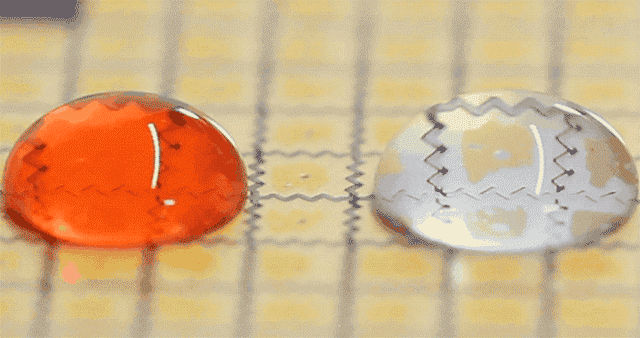| Programming Droplets |
| Written by David Conrad | |||
| Saturday, 28 April 2018 | |||
|
Perhaps the Programmable Droplets system showcased in this video is a solution in search of a problem, or perhaps it is just a solution. Whatever, it is really fun to watch and programming it to play games would be even more fun. There isn't a lot of information on exactly how the system works and sadly there isn't a how-to-build-it. If anyone knows more please share it with us. A grid of electrodes is modulated in some way to make drops of water, or similar fluid, move around. It is based on electrowetting which, if you check Wikipedia, you will discover is the way that voltages can modify the angle of contact between a drop and a surface. If you look closely at the video you can see that what seems to happen is that the drop is deformed so that it moves in a particular direction.
Watch the video and take note of how the drops move:
I particularly liked the way a small drop could seem to chase another and then swallow it up. This suggests some sort of pacman game, or what about snake? This is all a graduate thesis project by Udayan Umapathi and a team from MIT Tangible Media Group. "To illustrate how droplets in our living environment can become interactive we have created a device that can be integrated into various everyday objects, to function as information display, to help make art, enable play and display messages. The Programmable Droplets system utilizes the technique of “electrowetting on dielectric” (EWOD). This technique enables a set of primitive operations, such as precisely translating, morphing, merging, and splitting multiple droplets simultaneously. While these techniques have been previously applied to biological automation by other researchers and our own group, we have now started applying these techniques to create water based computer interfaces." I'm not sure that I believe the suggested applications, but I do think there is scope for an artwork based on this principle and perhaps even an executive toy - remember those? I can't see that there are many applications for moving drops on the open surface of a plate and most fluidic systems use tubes and chambers to perform reactions, but perhaps I'm just not thinking out of the phial sufficiently.
More InformationProgrammable Droplets for Interaction Related ArticlesA Water Droplet-Based Computer Water In WebGL - One You Have To See Interactive Fluid Simulation in WebGL OpenGL 3D fluid simulation (video)
To be informed about new articles on I Programmer, sign up for our weekly newsletter, subscribe to the RSS feed and follow us on Twitter, Facebook or Linkedin.
Comments
or email your comment to: comments@i-programmer.info
|
|||
| Last Updated ( Saturday, 28 April 2018 ) |



